Please Note: This article is written for users of the following Microsoft Word versions: 2000, 2002, and 2003. If you are using a later version (Word 2007 or later), this tip may not work for you. For a version of this tip written specifically for later versions of Word, click here: Getting Rid of Modify Style Message.
Like many Word users, Judie uses custom styles in her documents. Recently, in Word 2003, Judie has started getting a Modify Style message asking her if she wants to "update the style to reflect recent changes?" or "reapply the formatting of the style to the paragraph" with a checkbox to "automatically update the style from now on." Judie does not want to see this message at all; she wants her styles applied exactly the way she created them, and she will explicitly choose whether to modify a style or not.
Getting rid of this message can be accomplished by following these steps:

Figure 1. The Edit tab of the Options dialog box.
With the above steps firmly in mind, it is important to understand why someone would see the Modify Style message described by Judie. Let's say you have a paragraph that has the MyPar style applied to it. (This is a custom style you previously created.) If you try to reapply the MyPar style to it and there have been no explicit formatting changes to the paragraph, then you won't see the message. If you try to reapply the MyPar style to it and there have been explicit formatting changes, then you will see the message. Why? Because Word thinks you might want to "codify" the explicit changes you made so they are saved in the style.
The short way around seeing the message—even without explicitly turning it off, as described above—is to not reapply a style. Instead, select the paragraph and press Ctrl+Q to return paragraph formatting to whatever the underlying style says it should be, or press Ctrl+Spacebar to return character formatting to whatever the style says it should be. Both shortcuts bypass the unwanted message concerning styles and get you to the same point that you would be at if you chose to simply reapply the style in the message's dialog box.
WordTips is your source for cost-effective Microsoft Word training. (Microsoft Word is the most popular word processing software in the world.) This tip (445) applies to Microsoft Word 2000, 2002, and 2003. You can find a version of this tip for the ribbon interface of Word (Word 2007 and later) here: Getting Rid of Modify Style Message.

Do More in Less Time! An easy-to-understand guide to the more advanced features available in the Microsoft 365 version of Word. Enhance the quality of your documents and boost productivity in any field with this in-depth resource. Complete your Word-related tasks more efficiently as you unlock lesser-known tools and learn to quickly access the features you need. Check out Microsoft 365 Word For Professionals For Dummies today!
Want to see all the built-in styles in the Style drop-down list? Here's the quick way to do it.
Discover MoreIf you spend a lot of time getting your document styles set "just right," you don't want to take the chance that they ...
Discover MoreUsing the Styles and Formatting task pane, Word allows you to select all instances of a given style in your document. ...
Discover MoreFREE SERVICE: Get tips like this every week in WordTips, a free productivity newsletter. Enter your address and click "Subscribe."
There are currently no comments for this tip. (Be the first to leave your comment—just use the simple form above!)
Got a version of Word that uses the menu interface (Word 97, Word 2000, Word 2002, or Word 2003)? This site is for you! If you use a later version of Word, visit our WordTips site focusing on the ribbon interface.
Visit the WordTips channel on YouTube
FREE SERVICE: Get tips like this every week in WordTips, a free productivity newsletter. Enter your address and click "Subscribe."
Copyright © 2026 Sharon Parq Associates, Inc.
Comments